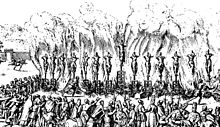Agustín de Cazalla
Agustín de Cazalla (1510-1559) was a Spanish clergyman, with humanist and Erasmist tendencies, who was prosecuted for founding a Protestant sect in Valladolid.
Cazalla was subjected to a carefully managed trial by the Inquisitor General, Fernando de Valdés, who communicated his findings to King Philip II.
The corpse of his mother Doña Leonora de Buiero was disinterred and thrown into the fire and as the "heretical" Lutheran conventicles had taken place in her home, the house was razed to the ground.
A marble 'column of infamy' erected in its place, bore an inscription prohibiting the rebuilding of the house, or removal of plaque under penalty of excommunication and banishment from the Spanish realms.
One account attributed Cazalla's "heresy" to: In one of the various accounts of Cazalla's last words he addresses Princess Juana of Austria (sister of Philip II, regent in his name) who had presided over the Auto-da-fé, saying: "I gave you good doctrine; I preached well to you but for myself I chose the worst, I thought that this corruption was a golden mitre; and because of my evil works, I deserve what I get.
Although the tombstone has not been preserved and no drawings exist, several copies of the text survive, some from the plate when it was dismantled and others from the City Council archives.
"[6] A description thought to have been by an eyewitness, relates; "The first paragraph is written in a triangle and the second in a rectangle, so it is assumed that the plate had a semicircular shape at the top.

